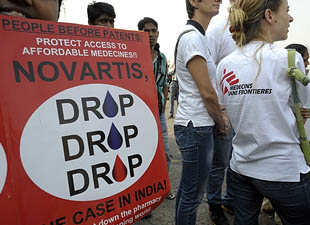
AsianScientist (Apr. 5, 2013) – After a seven year protracted battle in various courts, the Supreme Court of India finally rejected a patent application by Swiss pharma giant Novartis earlier this week (April 1) for an updated version of the anti cancer drug Glivec (imatinib mesylate).
This case is seen as one of the highest profile cases in India – keenly watched by the international pharmaceutical industry and health activists alike – with wide ranging implications for not only India but also other developing countries.
Glivec is used for treating chronic myeloid leukemia (CML) and some other forms of cancers.
The Indian Supreme Court held that the new version of the drug differed slightly from the older known version but not substantially enough to categorize it as a novel product, and hence denied a patent to Novartis.
The controversy revolves around the interpretation of a provision of the Indian Patents Act called Section 3(d), which disallows patenting of new forms of already known molecules. This provision prevents the ‘evergreening’ of patents by interested entities who slightly tweak patented molecules and seek a fresh patent beyond the normal duration of 20 years, thus posing a long-term challenge to the availability of affordable and cheap medicines to patients, especially in developing countries.
Pharma multinationals have been accused by non-profit health groups of earning large profits through patented medicines. While Novartis sells Glivec at Rs.120,000 (US$2,400) per monthly dose, its Indian generic equivalents cost only Rs. 8,000-12,000 (US$160-$240) for a monthly dose.
In 1998, Novartis had applied for a product patent on the beta crystalline form of imatinib mesylate, the original molecule having been discovered in early 1990s and patented by Novartis in the United States and other developed countries in 1993.
In 2006, the Chennai Patent Office rejected Novartis’ new application on grounds of lack of novelty and increased efficacy over the already known substance. Novartis filed an appeal against the rejection of its patent application and also challenged the constitutional validity of Section 3(d) in the Chennai High Court. In 2009, the Intellectual Property Appelate Board rejected Novartis’ appeal against Section 3(d) and Novartis approached the Supreme Court in 2009 which rejected its plea this week.
The Supreme Court judgement is widely seen as a setback for the multinational pharmaceutical lobby which may have been looking forward to protecting its turf by the ‘evergreening’ of existing patents.
Quite clearly, its reverberations will be felt in various other cases – many already in various stages of litigation in Indian courts – involving Indian generic manufacturers and competing multinational companies.
On the heels of the Novartis judgement, Merck, Sharp & Dohme (MSD) has taken Mumbai based Glenmark Pharmaceuticals to the Delhi High Court alleging infringement of its patent for its anti diabetes blockbuster drugs, Januvia and Janumet. Glenmark is marketing its Zita and Zita-Met drugs as branded generics which are priced 30 percent cheaper than Merck’s products.
Novartis says court decision discourages drug innovation
Novartis described the primary concern of the case as one of India’s growing non-recognition of intellectual property rights that sustain research and development for innovative medicines. It dubbed the judgement as one that discourages innovative drug discovery essential to advancing medical science for patients.
“We brought this case because we strongly believe patents safeguard innovation and encourage medical progress, particularly for unmet medical needs,” said Ranjit Shahani, Vice-Chairman and Managing Director, Novartis India Limited. “This ruling is a setback for patients that will hinder medical progress for diseases without effective treatment options,” he added.
But the patients groups have been ecstatic over the judgement. Y K Sapru of Cancer Patients Aid Association (CPAA), which fought Novartis in court, said, “We are very happy that the apex court has recognized the right of patients to access affordable medicines over profits of big pharmaceutical companies through patents.”
International medical humanitarian organization Medecins Sans Frontieres (MSF) or Doctors Without Borders described the judgement as a major victory for patients’ access to affordable medicines in developing world.
“This is a huge relief for millions of patients and doctors in developing countries who depend on affordable medicines from India and for treatment providers like the MSF,” said Dr. Unni Karunakara, MSF’s International President.
“By refusing patent monopolies on minor changes to known molecules, this judgement will acilitate early entry of generic medicines into the market for other medicines and diseases too,” says Anand Grover, director of Lawyer’s Collective who represented the CPAA. “The impact will be felt not only in India but across the developing world,” he added.
The Indian Drug Manufacturers Association (IDMA), an apex body of indigenous (non-multinational) drug manufacturing companies, has also, quite understandably, welcomed the Supreme Court judgement. The Indian drug industry ranks third largest in volume (10 percent) and 14th (1.5 percent) in value globally. It tops the world in exporting generic medicines, valued at US$11 billion annually. This number is expected to cross US$16 billion by 2013-14, according to the IDMA.
In 2011, global generic drug spending was estimated to be US$267 billion, and is expected to rise to $400-430 billion by 2015, nearly 70 percent of which will be outside developed countries.
Drugs with an estimated combined annual sales of US$150 billion are slated to go off-patent by 2015. Backed by the recent Supreme Court judgement, Indian firms are expected to rake in profits with the patent expiration of blockbuster drugs looming in the horizon.
——
Copyright: Asian Scientist Magazine; Photo: Novartis Oncology.
Disclaimer: This article does not necessarily reflect the views of AsianScientist or its staff.











